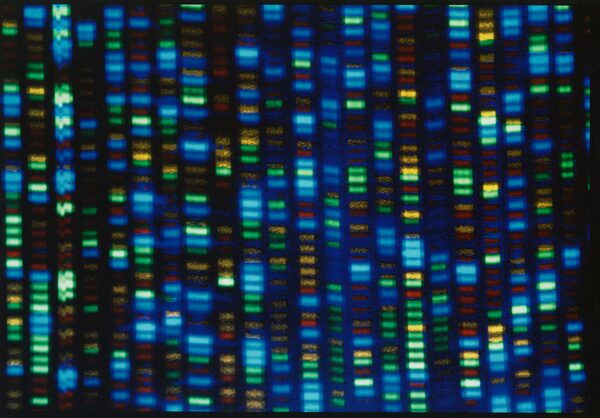
This undated image made available by the National Human Genome Research Institute shows the output from a DNA sequencer.The Associated Press
Let’s Talk Science and the Royal Society of Canada have partnered to provide Globe and Mail readers with relevant coverage about issues that affect us all – from education to the impact of leading-edge scientific discoveries. Let’s Talk Science offers a number of fun activities to get youth engaged in STEM.
Be a biochemist! Learn how to extract DNA from an onion and find out what DNA looks like.
What You Need
· 120 mL water
· 5 g table salt (approximately 1.5 teaspoon)
· 5 g baking soda (approximately 1 teaspoon)
· 5 mL dish soap (approximately 1 teaspoon)
· 10 mL isopropanol (or rubbing alcohol) – found in pharmacies
· 1/8 of an onion
· Knife
· Small bowl
· 4 small plastic containers (preferably see-through)
· Paper coffee filter
· Rod or skewer
· Teaspoon
· Measuring cup
· Regular spoon
Safety first! Use caution when handling sharp objects. Wear safety goggles to ensure your eyes are protected.
What to Do
1. Make a DNA extraction solution by mixing the water, soap, salt, and baking soda in a labelled container (labelled as “DNA extraction solution”).
2. Cut the onion into small pieces and place the pieces into a bowl with a small amount of water. Using the knife, finely mince the onion in the bowl and crush with the back of a spoon. The final consistency should be slightly coarser than applesauce.
3. Mix 4 teaspoons of onion mixture with 8 teaspoons of DNA extraction solution in a container.
4. Stir vigorously with the rod or skewer for five minutes.
5. With the coffee filter, strain the onion/extraction solution into a clean container. Keep the liquid that flows through the filter and discard the coffee filter with the onion debris.
6. Using the measuring spoon, measure about 10 mL (2 teaspoons) of the onion/extraction mixture into another of the plastic containers.
7. Add an equal volume of isopropanol (approximately 10 mL or 2 teaspoons) and stir slowly with the rod or skewer.
8. Observe what happens while stirring. Long strands of DNA should appear in the solution. They will appear like long, white, thin strings. Try wrapping the strands around the rod or skewer to have a better look at them.
What’s happening?
Every living cell contains DNA. This includes cells from animals, bacteria, fungi and plants.
A membrane composed of lipids (fats) and proteins surrounds each cell. By cutting the onion into very small pieces, the cell membranes are broken open. Mixing the broken cell membranes with the extraction solution allows the lipids and proteins to be solubilized (or dissolved in the liquid) by the detergent in the soap. When poured through the coffee filter, the debris is trapped; however, the solubilized DNA is able to flow through. The baking soda acts as a buffering agent that keeps the solution at an optimal pH (degree of acidity or basicity) for the DNA.
The salt, in combination with the isopropanol, precipitates, or pulls out, the DNA from the liquid solution since DNA is not soluble in isopropanol. Therefore, the addition of isopropanol allows the DNA to be seen by the naked eye. If the DNA was to be placed in water, it would seem to disappear because DNA is soluble in water.
Why does it matter?
DNA extraction is an important molecular biology technique. With the advent of new extraction techniques, the uses of DNA extraction and sequencing will continue to multiply. Currently, a few uses include the following:
· Genetic fingerprinting: A process that depends on the uniqueness of a person’s DNA and is used to match a genetic sample with a potential source. This technique is used by forensic scientists.
· Genetic modification: Agricultural companies use DNA extraction to modify the DNA of certain plant species. They can modify crops to be more tolerant or resistant to certain conditions. For instance, they may modify a grain crop to be resistant to the effects of an herbicide (an agent that kills plants) so that the herbicide will only affect the weeds.
· Medical diagnosis: Certain medical conditions carry specific DNA markers that allow scientists to identify the presence or absence of a disease from a DNA sample.
Investigate further
· Try this activity using bananas instead of onion. Onions are diploid organisms, meaning that they have two sets of chromosomes, one set from each parent. Bananas are triploid, with three sets of chromosomes - two sets from one parent and the third from the other parent. When you replicate the experiment using bananas, are there any differences in how the DNA looks?
· Try this with other vegetables and fruits and see what happens. If you take DNA from a tetraploid organism (potato, turnip, cabbage), a hexaploid organism (kiwi), or an octaploid organism (strawberry), does their DNA look the same or different? What is the colour of the DNA you extract from a kiwi or a strawberry?
For more information on this topic check out these Let’s Talk Science resources:
· DNA Extraction (Backgrounders) - Learn the basics of how DNA can be extracted from cells.
· DNA Damage and Repair (Backgrounders) - This backgrounder explains the different ways that cells repair damage to DNA.
· The Classification of Life: From Linnaeus to DNA Barcoding (Backgrounders) - Learn about two taxonomy systems that scientists use to classify the life around us.
Discover more free, English and French, Let’s Talk Science hands-on STEM activities, resources and events online.